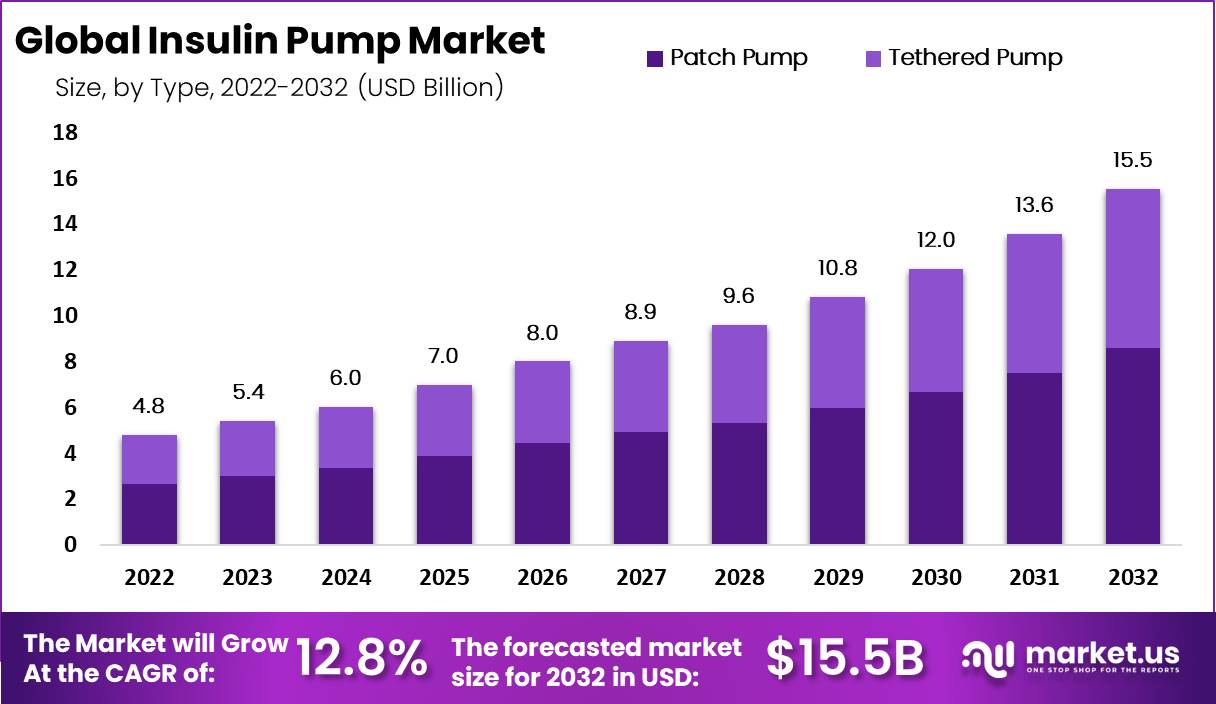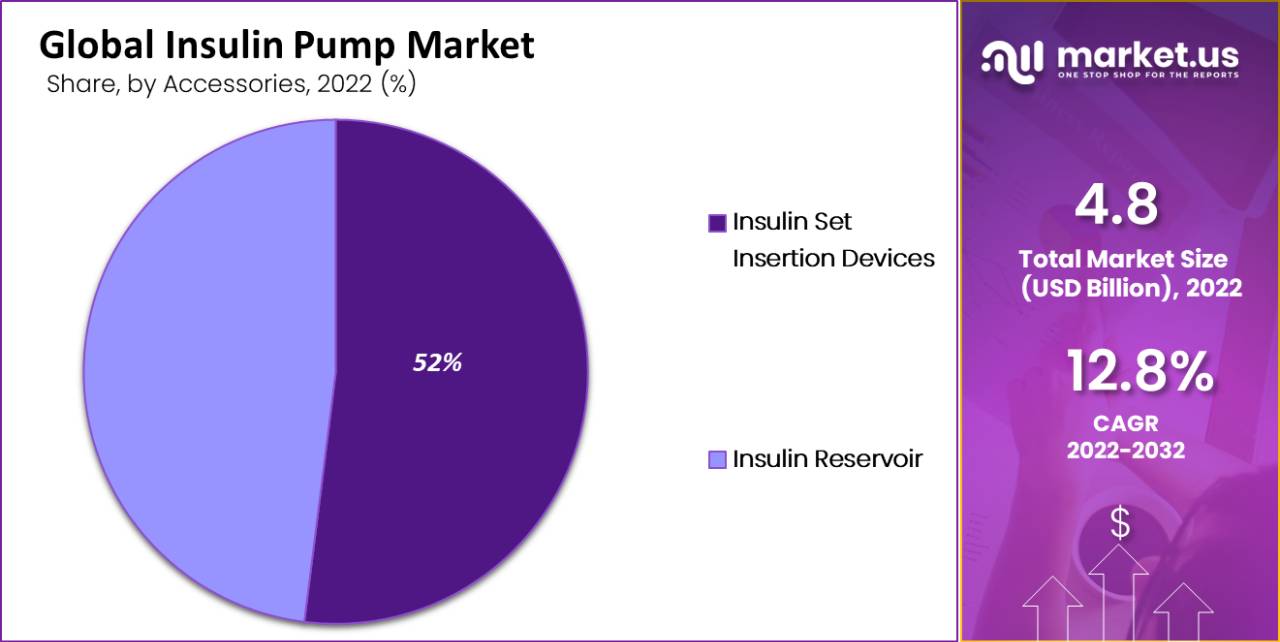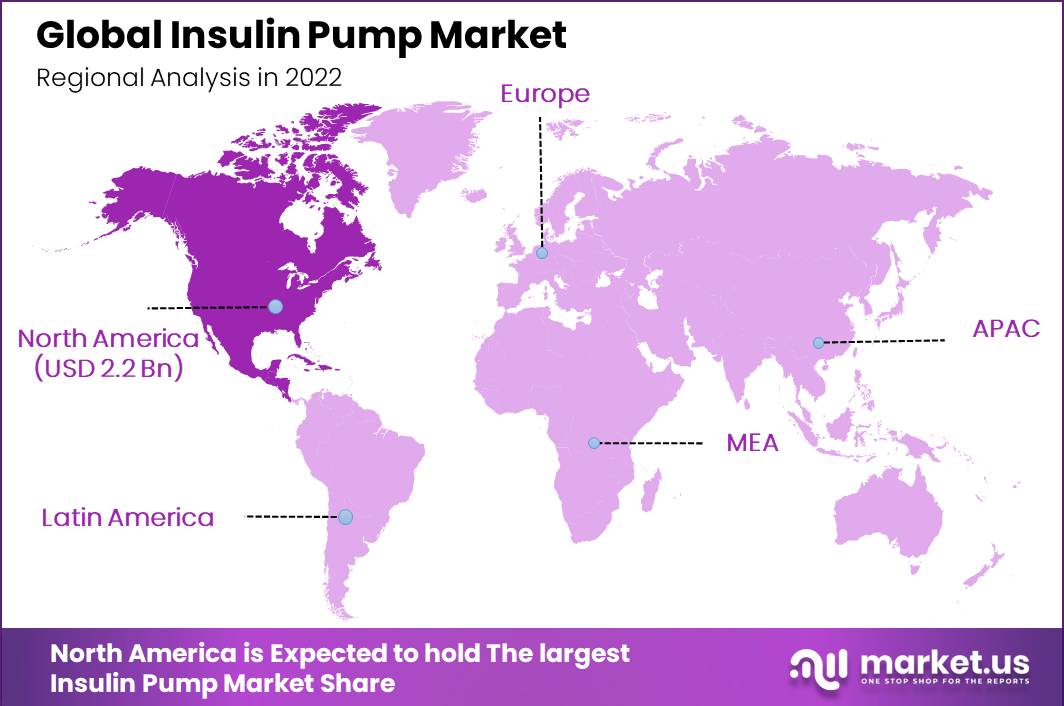Global Insulin Pump Market by Type (Patch Pump and Tethered Pump), By Accessories (Insulin Set Insertion Devices and Insulin Reservoir), By End User, By Region and Companies - Industry Segment Outlook, Market Assessment, Competition Scenario, Trends, and Forecast 2023-2032
- Published date: Oct 2023
- Report ID: 102127
- Number of Pages: 344
- Format:
- keyboard_arrow_up
Quick Navigation
Report Overview
In 2022, the global Insulin Pump Market was valued at US$ 4.86 billion. Between 2023 and 2032, this market is estimated to register the highest CAGR of 12.8%. It is estimated to reach a valuation of US$ 15.5 billion by 2032.
Diabetes patients can receive their prescribed amounts of insulin using insulin pumps, which are small, programmed medication delivery systems. The widespread adoption of insulin pumps has been facilitated by their increasing effectiveness in regularly treating and controlling diabetes by delivering consistent and timely insulin doses. The insulin pump market is extremely dependent on the geriatric population.

The rising prevalence of type 1 and type 2 diabetes is the main factor driving the need for insulin pumps. Overweight and obesity lead to an increased occurrence of type II diabetes. That’s why risk factors such as smoking, overweight, obesity, and high cholesterol are expected to increase the prevalence of type II diabetes.
By 2032, it is predicted that 798 million people will have diabetes worldwide, according to information provided by the International Diabetes Federation. The World Health Organization claims that diabetes significantly contributes to kidney failure, blindness, and stroke.
Key Takeaways
- The Insulin Pump Market was worth $4.86 billion in 2022.
- It is expected to grow at a CAGR of 12.8% from 2023 to 2032.
- By 2032, the market is projected to reach a valuation of $15.5 billion.
- The rising diabetic population is a significant factor contributing to market growth.
- Obesity and aging are major risk factors for diabetes.
- Advances in healthcare have increased life expectancy, leading to a higher prevalence of diabetes.
- Electronic insulin pumps are preferred for their convenience and accuracy in insulin delivery.
- Insulin pumps are expensive, making them less accessible to many consumers.
- A lax regulatory framework allows pharmaceutical companies to set high drug prices.
- In 2022, patch pumps dominated the market, offering convenience and no need for tubes.
- Tethered pumps are expected to dominate the market, driven by their reliability and a wide range of available products.
- Insulin set insertion devices accounted for the largest revenue share in 2022.
- The insulin reservoir market is anticipated to grow rapidly, driven by the adoption of tethered pumps.
- Hospitals dominated the market in 2022 due to increased penetration and qualified medical professionals.
Drivers
The rising diabetic population
The exact cause of diabetes is unknown. However, years of research, studies, and research have produced a list of factors that can significantly increase the risk of diabetes. The major factors are obesity and aging. Nearly 40% of the world’s population is now obese. A sedentary lifestyle and an unhealthy diet are the most common causes of obesity and overweight.
Advances in healthcare have increased life expectancy worldwide. Therefore, the proportion of the elderly population in the total population is increasing. The elderly population is at increased risk of developing diabetes. As a result, the number of diabetics is likely to increase as more and more people become obese or overweight and age.
As awareness of diabetes management and care grows, electronic insulin pumps are preferred by both physicians and consumers. This is because the new generation pumps are convenient, safe, and provide accurate results compared to traditional methods. Anytime, Anywhere The nature of digital technology allows patients to address their health concerns by connecting and sharing data with their healthcare team. The factors mentioned above are expected to drive the growth of the market.
Restraints
Expensive Insulin Pumps
Patients need to take insulin regularly because insulin is necessary to sustain life. These medical devices are the subject of extensive research, development, and innovation requiring huge amounts of capital. After obtaining the necessary approvals, the product is launched, and the company that developed the product must reach break-even and be profitable before the patent expires. In addition, only a few players are in the market, giving you great power over the market price.
A lax regulatory framework and other policy issues allow pharmaceutical companies to set high drug prices without accountability or oversight. Most consumers do not have access to insulin pumps due to their high cost. Subsequent maintenance is expensive, restraining the average person from buying an insulin pump. As a result, the high price of insulin pumps hinders market expansion.
Type Analysis
Based on type, the market for insulin pumps is segmented into patch pumps and tethered pumps. Among these types in 2022, the patch pumps category dominated the market. Patch pumps are tiny, digital insulin pumps that can be affixed to the skin’s surface. Patch pumps offer increased patient convenience because no tubes are needed to connect the pump and cannula.
Patch pumps can be integrated into or linked to smartphone applications that assist in monitoring blood glucose levels to improve insulin sensitivity. The segment’s expansion will also be aided by using technology to improve features that improve insulin delivery.
Tethered pumps will dominate the market, with patch pumps as a growth leader. When the pump is connected, the plastic cannula and pump are separated by a flexible hose. The reliability of these classic pumps and the abundance of items currently on the market are the two main factors responsible for the significant growth of this market segment.
Accessories Analysis
The accessories market segment is set to be emerging in the insulin pump market. The insulin set insertion devices have a major share in the market, accounting for the largest revenue share in 2022, and is anticipated to continue to rule the market during the projection period.

The market for insulin reservoirs or cartridges is anticipated to increase rapidly over the predicted period. The increasing adoption of tethered pumps drives the growth of the insulin reservoir. This involves loading a new insulin cartridge into the insulin reservoir or extracting insulin into the reservoir.
End-User Analysis
The hospital segment dominated the market and accounted for the largest revenue share in 2022. This is simply due to the increasing penetration of hospitals worldwide daily. Qualified medical professionals who can help people with diabetes effectively cure their diabetes have driven the growth of this segment. Increasing investment in hospital development by governments and companies is expected to further drive the growth of the hospital segment in the near future.
Secondly, the healthcare segment is growing due to the rising healthcare costs, growing awareness of the availability of insulin pumps, and the ease of obtaining insulin pumps through online and offline retail pharmacies have significantly powered the market growth of the home healthcare segment. Additionally, integrating smart technologies, such as artificial intelligence, in the medical field drives patients’ acceptance of automatic insulin pumps.
Key Market Segments
Based on Type
- Patch Pump
- Tethered Pump
Based on Accessories
- Insulin Set Insertion Devices
- Insulin Reservoir
Based on End-User
- Hospitals
- Clinics
- Homecare
- Laboratories
Opportunity
Evolving Insulin Pump Technologies
The increasing prevalence of diabetes has prompted private market participants to invest in better insulin delivery systems to take advantage of the growing diabetes market. Insulin dependence requires regular doses of insulin that are appropriate for the body’s needs. However, given the busy lifestyle patterns of the modern world, tracking blood sugar levels, health awareness, and injecting insulin when needed can be difficult and cumbersome.
Additionally, insulin injections are not the most convenient drug delivery for the elderly. There is a growing demand for integrating artificial intelligence and machine learning in developing computer-assisted insulin pumps that automatically administer insulin as needed after calculating the body’s needs. Product innovations with technological advancements to enhance the insulin delivery system will offer lucrative opportunities for the market.
Trending Factors
The insulin infusion pump market is likely to continue to grow due to rising obesity rates, rising genetic factors for type 2 diabetes, and increasing numbers of people with type 1 diabetes.
Insulin pump manufacturers are increasingly focused on product innovation and differentiation as they steadily move toward consolidation through key factors: mergers & acquisitions, joint ventures, and collaborative partnerships. Such trends are currently being witnessed in this market, bolstering the demand for insulin pumps in the growth of the market.
Regional Analysis
North America Covers Major Market Share than Others.
North America dominates the insulin pump market, with a major revenue share of approximately 47.8% in 2022 due to the presence of major players in insulin pumps. Additionally, rising obesity rates, high treatment costs, technological advancements, and product launches are expected to drive the market in the region.
Europe is also expected to gain a large market share during the forecast period due to the increasing elderly population prone to diabetes. Additionally, improvements in healthcare and the introduction of modern medical products have increased the demand for insulin pumps.

Asia Pacific is expected to be a favorable region for the insulin pump market. Rising healthcare funding and government initiatives to raise awareness of diabetes are key growth drivers in the region. China is expected to lead its APAC region in 2022 due to its economic growth and large diabetic population. Moreover, introducing new technologies in developing countries is expected to boost the market.
Key Regions
- North America
- The US
- Canada
- Mexico
- APAC
- China
- Japan
- South Korea
- India
- Australia & New Zealand
- Indonesia
- Malaysia
- Philippines
- Singapore
- Thailand
- Vietnam
- Rest of APAC
- Western Europe
- Germany
- France
- The UK
- Spain
- Italy
- Portugal
- Ireland
- Austria
- Switzerland
- Benelux
- Nordic
- Rest of Western Europe
- Eastern Europe
- Russia
- Poland
- The Czech Republic
- Greece
- Rest of Eastern Europe
- Latin America
- Brazil
- Colombia
- Chile
- Argentina
- Costa Rica
- Rest of Latin America
- Middle East & Africa
- Algeria
- Egypt
- Israel
- Kuwait
- Nigeria
- Saudi Arabia
- South Africa
- Turkey
- United Arab Emirates
- Rest of MEA
Key Player Analysis
Medtronic leads the market with a strong position in the insulin pump market:
Key Market players are executing strategies such as mergers and acquisitions, partnerships, and launching new technologically advanced products and services to strengthen their market positions. Major players invest heavily in research and development to produce technologically advanced products. Key companies are adapting and heavily investing in new techniques.
Medtronic has received FDA clearance for the MiniMed 770G insulin product featuring Medtronic’s SmartGuard technology. It can be easily connected to a smartphone and even has modulation for children.
Other prominent players are developing various development strategies such as product launches, acquisitions, partnerships, and mergers that drive market growth and provide lucrative growth opportunities for market participants.
Market Key Players
- Medtronic plc
- F. Hoffmann-La Roche Ltd
- Tandem Diabetic Care Inc.
- Insulet Corporation
- Ypsomed AG
- Cellenovo
- Sooil Development
- Valeritas Inc.
- JingasuDelfu Co. Ltd.
- Cequr SA
- Vicentra B.V.
- Other Key Players
Recent Developments
- On June 2, 2022, Insulet Corporation, an international chief in tubeless insulin pump gadgets and technology, introduced funding of about USD two hundred million in its upcoming production facility in Johor over the following 5 years. This could produce the company’s Omnipod Insulin Management System as a part of its ambition to bolster its international production skills
- In April 2022, Ypsomed introduced a collaboration with Abbott and CamDiab to expand an incorporated AID (computerized insulin delivery) device. The new incorporated AID device is being designed to hyperlink Abbott’s FreeStyle Libre three with Ypsomed’s MyLife YpsoPump to make a smart and automated manner for handing over insulin with sensible glucose information
- On three June 2022, Diabeloop, an international chief in healing AI, and SOOIL Development Company, a pacesetter in advanced diabetes remedy, introduced a settlement for international improvement on the American Diabetes Association Scientific Sessions. The collaboration is expected to set up scientific trials to increase their cooperation and offer admission to their items to as many sufferers as viable through new revolutionary products.
Report Scope
Report Features Description Market Value (2022) USD 4.86 Bn Forecast Revenue (2032) USD 15.5 Bn CAGR (2023-2032) 12.8% Base Year for Estimation 2022 Historic Period 2016-2022 Forecast Period 2023-2032 Report Coverage Revenue Forecast, Market Dynamics, COVID-19 Impact, Competitive Landscape, Recent Developments Segments Covered By Type – Patch pump and Tethered Pump; By Accessories – Insulin Set Insertion Devices and Insulin Reservoirs; By End-User – Hospitals, Clinics, Homecare, and Laboratories Regional Analysis North America – The US, Canada, & Mexico; Western Europe – Germany, France, The UK, Spain, Italy, Portugal, Ireland, Austria, Switzerland, Benelux, Nordic, & Rest of Western Europe; Eastern Europe – Russia, Poland, The Czech Republic, Greece, & Rest of Eastern Europe; APAC – China, Japan, South Korea, India, Australia & New Zealand, Indonesia, Malaysia, Philippines, Singapore, Thailand, Vietnam, & Rest of APAC; Latin America – Brazil, Colombia, Chile, Argentina, Costa Rica, & Rest of Latin America; the Middle East & Africa – Algeria, Egypt, Israel, Kuwait, Nigeria, Saudi Arabia, South Africa, Turkey, United Arab Emirates, & Rest of MEA Competitive Landscape Medtronic plc, F. Hoffmann-La Roche Ltd, Tandem Diabetic Care, Inc., Insulet Corporation, Ypsomed AG, Cellenovo, Sooil Development, Valeritas, Inc, JingasuDelfu Co., Ltd., Cequr SA, Vicentra B.V., Other Key Players. Customization Scope Customization for segments, region/country-level will be provided. Moreover, additional customization can be done based on the requirements. Purchase Options We have three licenses to opt for: Single User License, Multi-User License (Up to 5 Users), Corporate Use License (Unlimited User and Printable PDF) Frequently Asked Questions (FAQ)
What is the value and growth rate of the global insulin pump market?In 2022, the global insulin pump market was valued at US$ 4.86 billion. Between 2023 and 2032, it is estimated to register the highest CAGR of 12.8%.
How do insulin pumps benefit diabetes patients?Insulin pumps are small, programmed medication delivery systems that allow diabetes patients to receive their prescribed amounts of insulin. They deliver consistent and timely insulin doses, effectively treating and controlling diabetes.
What are the different types of insulin pumps available in the market?Patch pumps, which are tiny digital pumps affixed to the skin, dominated the market in 2022. Tethered pumps, connected through a flexible hose, are expected to dominate the market in the future.
What trends are driving the insulin pump market?Rising obesity rates, genetic factors for type 2 diabetes, and increasing numbers of people with type 1 diabetes are driving the growth of the insulin pump market.
What are some other main players in the insulin pump market?Besides Medtronic, other key players in the market include F. Hoffmann-La Roche Ltd, Tandem Diabetic Care Inc., Insulet Corporation, Ypsomed AG, Cellenovo, Sooil Development, Valeritas Inc., JingasuDelfu Co. Ltd., Cequr SA, Vicentra B.V., and other significant contributors.
Which end-users drive the demand for insulin pumps?The market caters to various end-users, including hospitals, clinics, homecare settings, and laboratories.
What impact does the rising diabetic population have on the market?The increasing diabetic population, driven by factors like obesity and aging, creates a higher demand for insulin pumps as a crucial tool for diabetes management.

- Medtronic plc
- F. Hoffmann-La Roche Ltd
- Tandem Diabetic Care Inc.
- Insulet Corporation
- Ypsomed AG
- Cellenovo
- Sooil Development
- Valeritas Inc.
- JingasuDelfu Co. Ltd.
- Cequr SA
- Vicentra B.V.
- settingsSettings
Our Clients
| Single User $4,599 $3,499 USD / per unit save 24% | Multi User $5,999 $4,299 USD / per unit save 28% | Corporate User $7,299 $4,999 USD / per unit save 32% | |
|---|---|---|---|
| e-Access | |||
| Report Library Access | |||
| Data Set (Excel) | |||
| Company Profile Library Access | |||
| Interactive Dashboard | |||
| Free Custumization | No | up to 10 hrs work | up to 30 hrs work |
| Accessibility | 1 User | 2-5 User | Unlimited |
| Analyst Support | up to 20 hrs | up to 40 hrs | up to 50 hrs |
| Benefit | Up to 20% off on next purchase | Up to 25% off on next purchase | Up to 30% off on next purchase |
| Buy Now ($ 3,499) | Buy Now ($ 4,299) | Buy Now ($ 4,999) |












